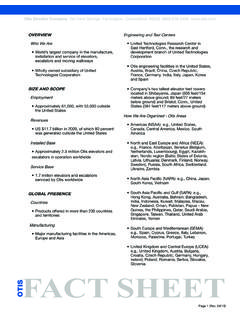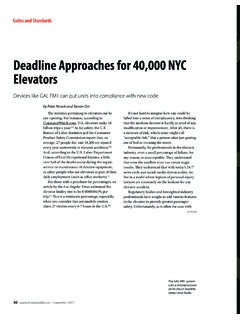Transcription of About Elevators Moving the world - Otis Elevator …
1 About ElevatorsMoving the worldImagine the skyline of a modern city if the Elevator didnot exist. Buildings would be limited to five or six of the architecture of the 20th and 21st centurywould be impossible. Office towers, hotels and high-riseapartments would hardly stand in their present form. Butin 1852, one man helped change the face of the world scities. That was the year Elisha Graves Otis invented thesafety Elevator , giving rise to the modern skyline. To gainsome idea of the effect of this one advancement, considerthat today, Elevators move the equivalent of the world spopulation every 72 Elevators1of 14 Otis Elevator Company has been safely and efficiently Moving peoplefor 150 years.
2 Today, Otis is the world s largest company in the manufacture and service of Elevators , escalators, Moving walks andpeople- Moving equipment. With more than million installationsand 61,000 employees, Otis can be found almost anywhere aroundthe globe. By creatively applying new technologies, Otis Elevator Companycontinues to set precedents for ride quality, reliability and safetythroughout the industry. This spirit of innovation, combined with out-standing customer service, has earned Otis Elevators a prominentplace in 10 of the world s 20 tallest buildings., About Elevators2of 14 Elisha Graves Otis was born in 1811on a farm in Halifax, Vermont.
3 As ayoung man, he tried his hand at sev-eral careers, all with limited , in 1852, his luck changed whenhis employer, the BedsteadManufacturing Company, asked himto design a freight to overcome a fatal haz-ard in lift design, unsolved since itsearliest days, Otis invented a safetybrake that would suspend the carsafely in the shaft if an Elevator cablesnapped. And the world s first safetylift was history of lifts, hoists and early Elevators The need for vertical transport is as old as the centuries, mankind has employed ingeniousforms of lifting. The earliest lifts used man, animal and water power to raise the load.
4 Lifting devices relied onthese basic forms of power from the early agriculturalsocieties until the dawn of the Industrial Revolution. In ancient Greece, Archimedes developed an improved lifting deviceoperated by ropes and pulleys, in which the hoisting ropes werecoiled around a winding drum by a capstan and 80, gladiators and wild animals rode crude Elevators up tothe arena level of the Roman records contain numerous drawings of hoists lifting menand supplies to isolated locations. Among the most famous is thehoist at the monastery of St. Barlaam in Greece. The monasterystood on a pinnacle approximately 61 meters (200 ft) above theground.
5 Its hoist, which employed a basket or cargo net, was theonly means up or an abbey on the French seacoast, a hoist was installed in 1203that used a large tread wheel. A donkey supplied the lifting load was raised by a rope wound on a large the 18th century, machine power was being applied to the devel-opment of the lift. In 1743, a counterweighted personal lift was commissioned by Louis XV in France for his personal chambers inVersailles. By 1833, a system using reciprocating rods raised andlowered miners in Germany s Harz Mountains. A belt-driven elevatorcalled the teagle was installed in an English factory in 1835.
6 Thefirst hydraulic industrial lift powered by water pressure appeared in1846. As machinery and engineering improved, other powered liftingdevices quickly Elevators3 of 14 Gears and rachetswere employed asmore complexmachinery becameavailable, but thehazard posed if thelifting rope broke was always supplied the liftingforce in many early on safety Despite these advances, one problem continued to trou-ble the Elevator as it had since ancient times. There wasno effective way to prevent the hoist from plummeting toearth if the lifting cable parted. This ever-present dangermade Elevators a risky 1852, Elisha Otis was working as a master mechanicat the Bedstead Manufacturing Company in Yonkers,New York.
7 He was given the assignment to design afreight Elevator to haul the company s products. Otis was aware of the inherent problem of cable failure andsought a solution that would eliminate the realized that some sort of safety brake was required. The brakehad to function automatically the instant the cable broke if it were tosave lives and property. Otis experimented by placing a wagonspring above the hoist platform. He then attached a ratchet bar tothe guide rails on each side of the hoistway. The lifting rope was fas-tened to the wagon spring in such a way that the weight of the hoistplatform exerted just enough tension on the spring to keep it fromtouching the ratchet bars.
8 If the cable snapped, however, the tensionwould be released from the spring and it would immediately engagethe ratchets, preventing the platform from the meantime, financial problems had forced the BedsteadCompany to close its doors. Otis was About to head west to takepart in the Gold Rush when an unsolicited order for two of his safetyhoisters arrived from a furniture manufacturer in New York. It seemstwo of its employees had been killed when a hoist rope had company wanted to prevent further tragedies. On September 20, 1853, Otis opened his own shop in part of thebankrupt Bedstead plant. In order to promote his new venture, Otisdecided to stage a dramatic demonstration of his new safety elevatorat the Crystal Palace Exposition in New the main exhibition hall, Otis constructed a complete safety eleva-tor equipped with guide rails, ratchets, spring, platform and hoistingmachinery.
9 Otis had the hoist fully loaded with freight. As a crowdgathered, he climbed on board and ordered the platform raised to fullheight. The hoisting rope was cut with an axe. The crowd before the platform could fall, the safety spring locked the lift inplace as Otis reassured the startled crowd with the cry, All safe,gentlemen. All safe. From that point on, sales climbed as customers began to associatethe Otis Elevator Company with safety. About Elevators4of 14 The patent diagram forthe Otis device that revolu-tionized the Elevator indus-try the world s first elevatorsafety brake. Since its inven-tion, the core design of thesafety brake has remainedessentially 1854, Elisha Graves Otispublicly demonstrated hissafety Elevator for the firsttime at the Crystal PalaceExposition in New York first Otis steam-poweredelevator was installed in and refinement Buildings in major American cities began rising abovethe sixth floor, taking advantage of the new opportunitiesprovided by the safety March 23, 1857, the world s first passenger safety Elevator wentinto service in a store at Broadway and Broome Street in New YorkCity.
10 The Elevator was powered by steam through a series of shaftsand belts. As the safety and efficiency of the early Elevators continued toimprove, space in buildings upper floors soon became more desir-able, reversing a long-standing trend in commercial and residentialleasing. By 1870, Otis Brothers & Company had revenues in excessof US$1 million. A couple of years later, there were no less than2,000 Otis Elevators in company continued to make technological advancements. In1878, Otis introduced a hydraulic Elevator that increased speeds to244 meters (800 ft) per minute. That same year Otis installed its firsthydraulic passenger Elevator at 155 Broadway in New York City.














